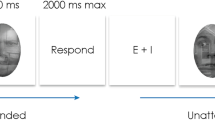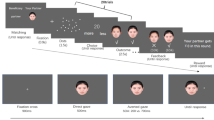Abstract
Pictures of either emotionally neutral, pleasant (affectionate), or unpleasant (threat and injury) scenes were paired with nonemotional control pictures and presented for 3 s, while eye fixations were monitored. Preferential attention to the emotional picture of eah pair occurred at an early processing stage: The probability of placement of the first fixation and the proportion of viewing time during the first 500 ms were higher for both pleasant and unpleasant pictures than for neutral pictures, whereas later fixation location and time were not differentially affected. This suggests that, when emotional and nonemotional stimuli are presented simultaneously, emotional meaning captures initial overt orienting and engages attention early, as measured by gaze direction and duration. The possibility that this effect could be accounted for by perceptual differences—such as luminance and complexity—between emotional and neutral pictures was ruled out.
Similar content being viewed by others
REFERENCES
Bradley, B., Mogg, K., & Millar, N. H. (2000). Covert and overt orienting of attention to emotional faces in anxiety. Cognition and Emotion, 14,789–808.
Bradley, M. M., Codispoti, M., Cuthbert, B. N., & Lang, P. J. (2001). Emotion and motivation: I. Defensive and appetitive reactions in picture processing. Emotion, 1,276–298.
Bradley, M. M., Cuthbert, B., & Lang, P. J. (1996). Picture media and emotion: Effects of sustained affective context. Psychophysiology, 33,662–670.
Bradley, M. M., Sabatinelli, D., Lang, P. J., Fitzsimmons, J. R., King, W., & Desai, P. (2003). Activation of the visual cortex in motivated attention. Behavioral Neuroscience, 117,369–380.
Buodo, G., Sarlo, M., & Palomba, D. (2002). Attentional resources measured by reaction times highlight differences within pleasant and unpleasant, high arousing stimuli. Motivation and Emotion, 26,123–138.
Center for the Study of Emotion and Attention [CSEA-NIMH]. (1999). The international affective picture system: Digitized photographs. Gainesville, FL: University of Florida, The Center for Research in Psychophysiology.
Christianson, S., Loftus, E. F., Hoffman, H., & Loftus, G. R. (1991). Eye fixations and memory for emotional events. Journal of Experimental Psychology: Learning, Memory and Cognition, 17,693–701.
Cuthbert, B. N., Schupp, H. T., Bradley, M. M., Birbaumer, N., & Lang, P. J. (2000). Brain potentials in affective picture processing: Covariation with autonomic arousal and affective report. Biological Psychology, 52,95–111.
Fox, E., Lester, V., Russo, R., Bowles, R., Pichler, A., & Dutton, K. (2000). Facial expressions of emotion: Are angry faces detected more efficiently? Cognition and Emotion, 14,61–92.
Hermans, D., Vansteenwegen, D., & Eelen, P. (1999). Eye movement registration as a continuous index of attention deployment: Data from a group of spider anxious students. Cognition and Emotion, 13,419–434.
Hoffman, J. E. (1998). Visual attention and eye movements. In H. Pashler (Ed.), Attention (pp. 119–153). Hove, UK: Psychology Press.
Junghöfer, M., Bradley, M. M., Elbert, T., & Lang, P. J. (2001). Fleeting images: A new look at early emotion discrimination. Psychophysiology, 38,175–178.
Klein, R., Kingstone, A., & Pontrefact, A. (1992). Orienting of visual attention. In K. Rayner (Ed.), Eye movements and visual cognition (pp. 46–55). New York: Springer-Verlag.
Lang, P. J., Bradley, M. M., & Cuthbert, B. (1997). Motivated attention: Affect, activation, and action. In P. J. Lang, R. F. Simmons, & M. T. Balaban (Eds.), Attention and orienting: Sensory and motivational processes (pp. 97–135). Mahwah, NJ: Erlbaum.
Lang, P. J., Bradley, M. M., & Cuthbert, B. (1998). Emotion and motivation: Measuring affective perception. Journal of Clinical Neurophysiology, 15,397–408.
Lang, P. J., Bradley, M. M., & Cuthbert, B. (1999). International Affective Picture System (IAPS): Technical manual and affective ratings. Gainesville, FL: University of Florida, The Center for Research in Psychophysiology.
Lang, P. J., Greenwald, M. K., Bradley, M. M., & Hamm, A. (1993). Looking at pictures: Affective, facial, visceral, and behavioural reactions. Psychophysiology, 30,261–273.
Mathews, A., & Mackintosh, B. (1998). A cognitive model of selective processing in anxiety. Cognitive Therapy and Research, 22,539–560.
Mogg, K., & Bradley, B. (1999). Orienting of attention to threatening facial expressions presented under conditions of restricted awareness. Cognition and Emotion, 13,713–740.
Mogg, K., Millar, N. H., & Bradley, B. (2000). Biases in eye movements to threatening facial expressions in generalized anxiety disorder and depressive disorder. Journal of Abnormal Psychology, 109,695–704.
Moltó, J., Montañés, S., Poy, R., Segarra, P., Pastor, M. C., Tormo, M. P., et al. (1999). Un nuevométodo para el estudio experimental de las emociones: El International Affective Picture System (IAPS). Adaptación española [A new method for the experimental study of emotions: The International Affective Picture System (IAPS). Spanish adaptation]. Revista de Psicología General y Aplicada, 52,55–87.
Ochsner, K. N. (2000). Are affective events richly recollected or simply familiar? The experience and process of recognizing feelings past. Journal of Experimental Psychology: General, 129,242–261.
öhman, A., Flykt, A., & Esteves, F. (2001). Emotion drives attention: Detecting the snake in the grass. Journal of Experimental Psychology: General, 130,466–478.
öhman, A., Lundqvist, D., & Esteves, F. (2001). The face in the crowd revisited: A threat advantage with schematic stimuli. Journal of Personality and Social Psychology, 80,381–396.
Pury, C. L., & Mineka, S. (2001). Differential encoding of affective and nonaffective content information in trait anxiety. Cognition and Emotion, 15,659–693.
Rohner, J. C. (2002). The time course of visual threat processing: High-trait anxious individuals eventually avert their gaze from angry faces. Cognition and Emotion, 16,837–844.
Schupp, H., Cuthbert, B. N., Bradley, M. M., Birbaumer, N., & Lang, P. J. (1997). Probe P3 and blinks: Two measures of affective startle modulation. Psychophysiology, 34,1–6.
Tipples, J., Atkinson, A. P., & Young, A. W. (2002). The eyebrow frown: A salient social signal. Emotion, 2,288–296.
Tipples, J., Young, A. W., Quinlan, P., Broks, P., & Ellis, A. W. (2002). Searching for threat. The Quarterly Journal of Experimental Psychology, 55A,1007–1026.
Vila, J., Sánchez, M., Ramírez, I., Fernández, M. C., Cobos, P., Rodríguez, S., et al. (2001). El Sistema Internacional de Imágenes Afectivas (IAPS): Adaptación española. Segunda parte [The International Affective Picture System (IAPS): Spanish Adaptation. Second part]. Revista de Psicología General y Aplicada, 54, 635-657.
Rights and permissions
About this article
Cite this article
Calvo, M.G., Lang, P.J. Gaze Patterns When Looking at Emotional Pictures: Motivationally Biased Attention. Motivation and Emotion 28, 221–243 (2004). https://doi.org/10.1023/B:MOEM.0000040153.26156.ed
Issue Date:
DOI: https://doi.org/10.1023/B:MOEM.0000040153.26156.ed




